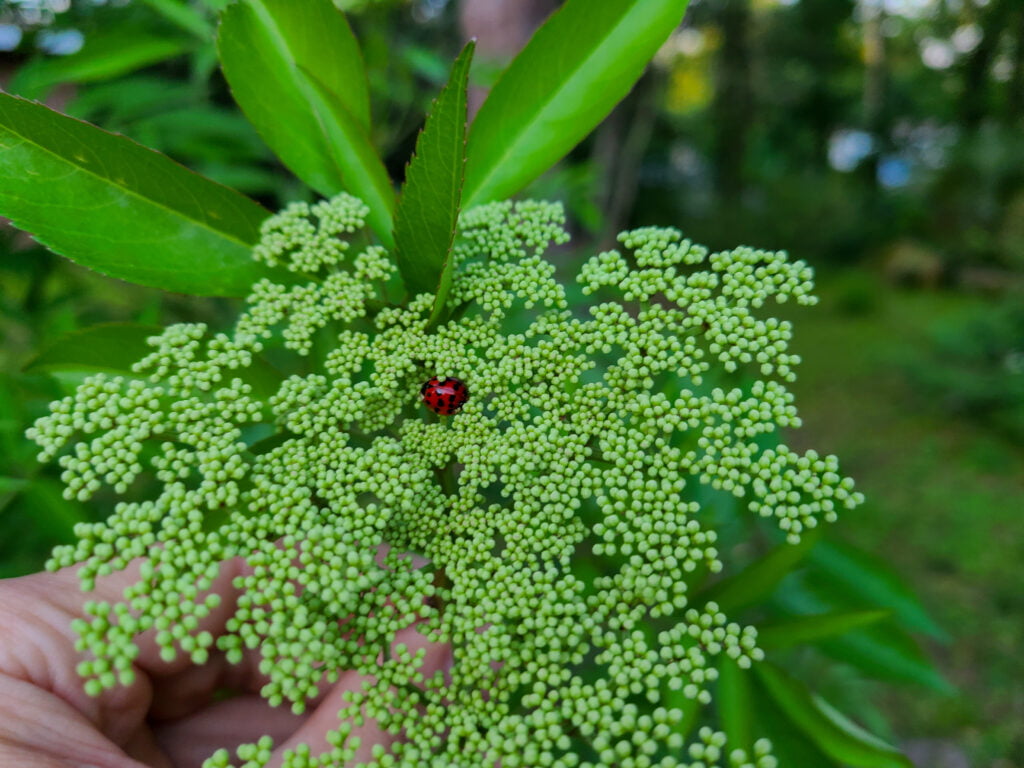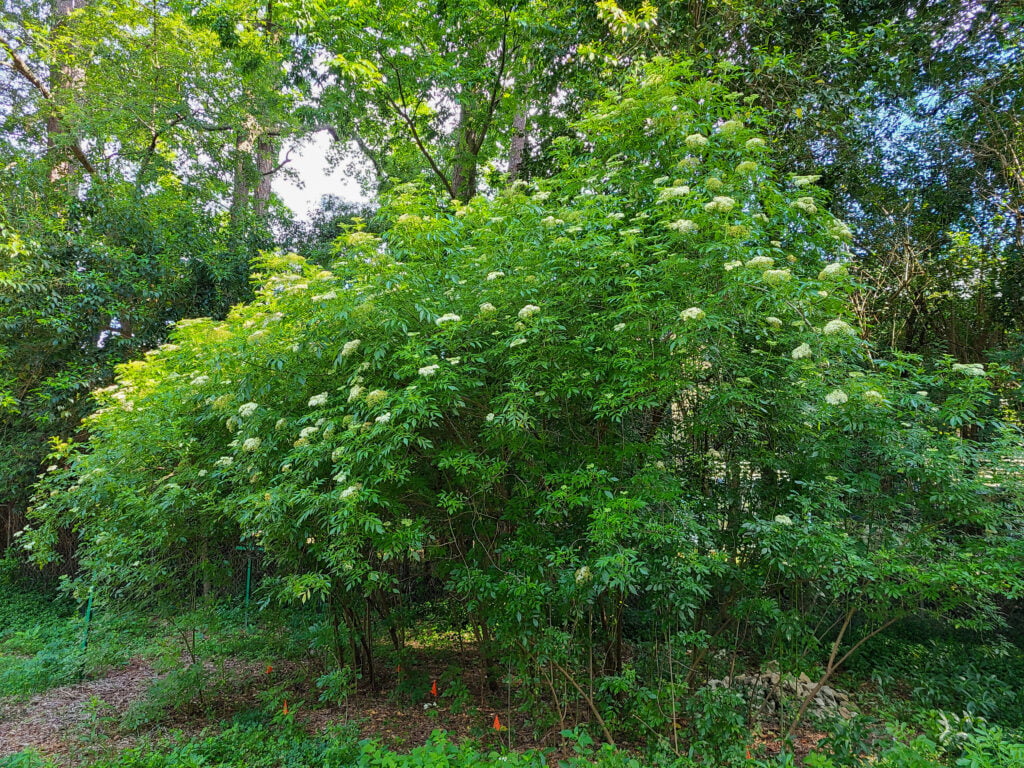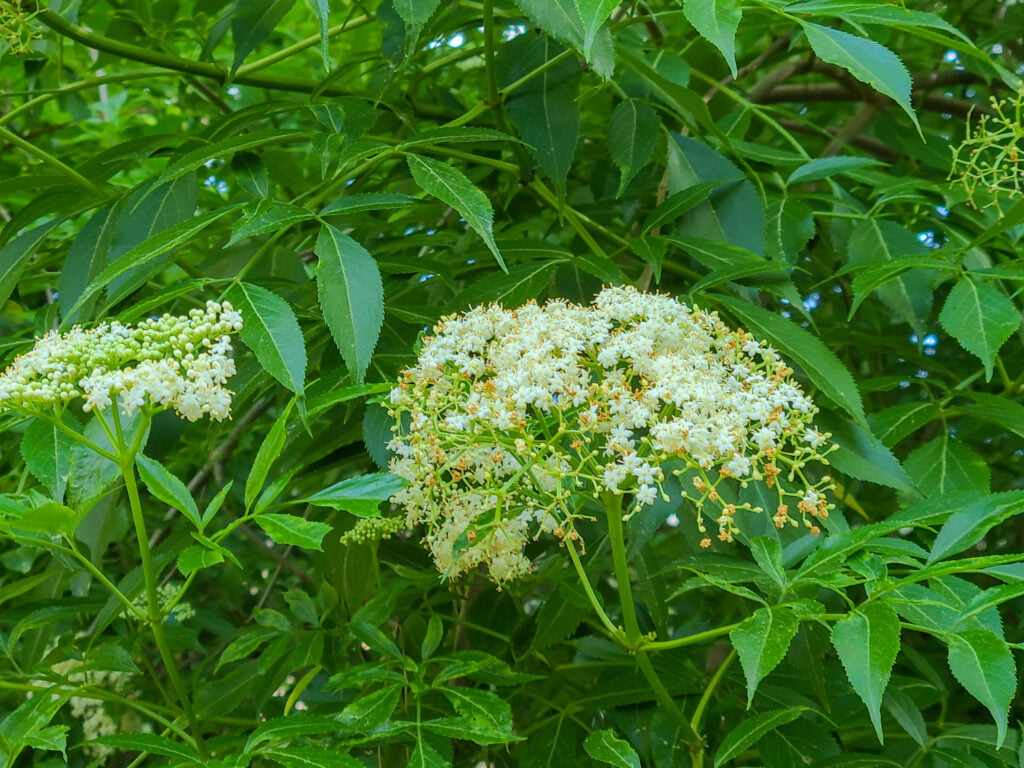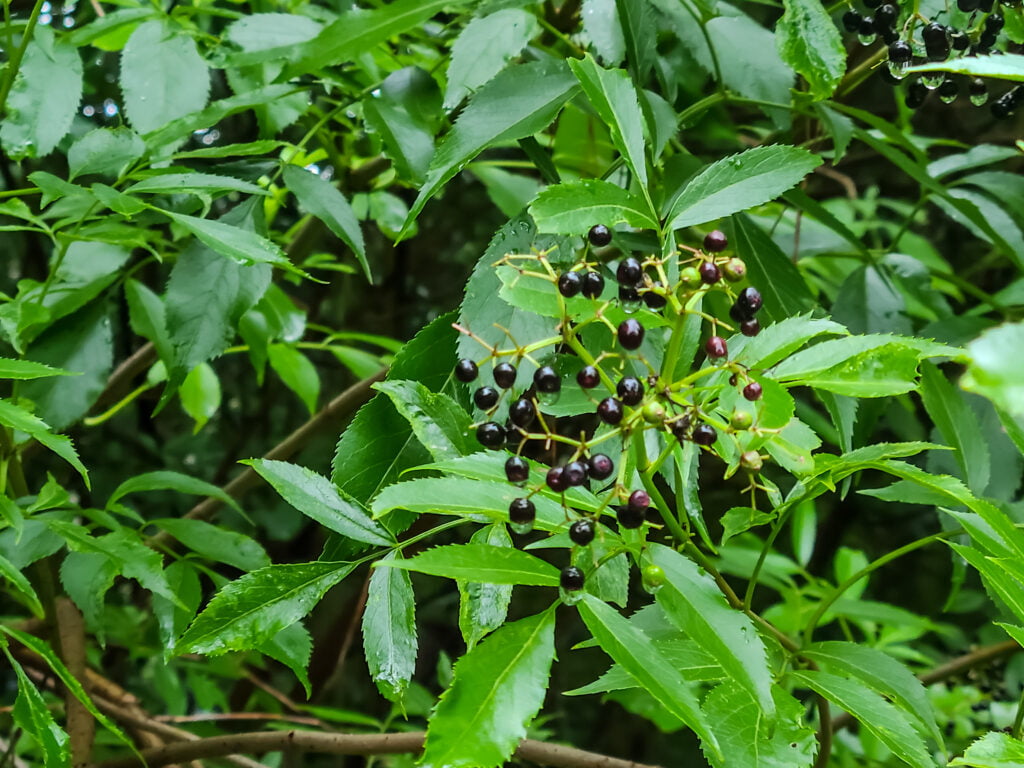Scientific name: Sambucus nigra L. ssp. canadensis (American elderberry)
Other common names: American black elderberry, Arizona elderberry, Americanelder, elder, sweet elder, wild elder, flor de saúco (Spanish), tree of music, Danewort, Walewort, New Mexican elderberry, kuuht (Serrano)1, hunqwat (Cahuilla), coskilpa / ta:bo:ci (Creek-Seminole), velvetleaf elder, hairy blue elderberry, and dwarf elder.
American elderberry is a variety of black elderberry (Sambucus nigra) that is native to most of the east, central, and southwest parts of North America.2 It has long been a sacred tree to the people of the Cahuilla Nation, in what is today considered Southern California.
The common name “elder” is from the Anglo-Saxon “ellen,” meaning fire-kindler, for the dry, pithy stems often used as kindling, and blue from the fruit color.3 The plant’s Spanish name “saúco” comes from the Latin Sambucus and this from the Greek σαμβύκη (sambuke), which refers to an ancient stringed musical instrument, a harp-like lyre, known as the sambuca. They were made from the wood of the elder tree.4
This plant profile is available as a zine:
Identification




American elderberry is a bush or small tree from 5 to 12 feet tall, depending on its age.
The leaves are oblong, oval with pointed ends, and have a sawtooth edge. They are arranged in groups of five or seven in opposite pairs, with leaves directly across from each other and one leaf at the point. Leaves are deciduous, meaning they are shed during winter annually.
The bark on new growth is green; on older branches and trunks, the bark is gray-brownish. The bark has distinctive bumps, and the older bark has vertical furrows that look like stretch marks. Stems are light, hollow, and easy to break.
Clusters of white flowers form in the late Spring. The flowers are tiny, have five petals, and are arranged in flat or dome-like clusters up to 10 inches across. In the Summer, the flowers become green berries that ripen to a dark purple or black color. The berries are usually fully ripe by August.5
Growing/Foraging
There are a few varieties of elderberry. Black elderberries have well-documented medicinal properties. There is a native European variety and many cultivated varieties that can be purchased online or at nurseries. There are also blue and red elderberries. Blue berried varieties are edible but of unknown medicinal use and red berried varieties are toxic.
A cultivar of the European Elderberry called S. nigra subsp. nigra ‘Marge’ is being studied for horticultural purposes in the Midwest, where most elders struggle. It boasts of less mite damage and higher yield. However, in addition to not being native, it does not fruit on first-year wood and, therefore, requires careful pruning regimens. 6
Elderberry trees like moist, fertile soil and full sun. They can be found in the wild, growing near bodies of water, in clearings, or on the edges of forested areas. It likes to grow in thickets sending up many new suckers from the root system to form new trunks around the base of existing trees.7
Some people may confuse elderberry and water hemlock. However, they are relatively easy to tell apart since elder is a shrub, meaning it has bark, while water hemlock is herbaceous, meaning it has hollow green and purple stems.8 Elder is also not to be confused with walnut (Juglans regia) which has alternately arranged leaves.
All varieties of Elderberry can be grown from root cuttings, hardwood cuttings, softwood cuttings, or seeds. Plants from seeds, while inconsistent in quality and berry production, may be hardier. Plants grown from cuttings are more uniform and produce flowers and berries sooner but have more fragile root systems.9 Once established, they require little water and are drought tolerant. They also require little in the way of fertilizer.10
However, if you want more flowers and berries, top dressing with compost, watering during dry periods, and balanced fertilizer will help. Check out this UF IFAS publication for everything you would want to know about growing elderberry.
The berries are very perishable and will go bad within a few hours in the Florida heat. They should be refrigerated as soon as possible and then either used, dried, or frozen within a few days.11
Sustainability
Native Sambucus varieties are generally prolific, growing along roadsides, woodlands, and even in parks. Elderberries can offer habitat through their natural multi-story arrangement. The plants provide shade, cool stream water, and their roots stabilize and create overhanging banks for fish and aquatic organisms. There are no issues with harvesting either flowers or berries besides the usual wild harvesting guidelines to take from abundant areas and take no more than 10% of what you find.
The berries are a food source for birds, squirrels, and bears, while deer, elk, and moose eat the stems and foliage. The plant is an especially important food source for many songbirds, and the valley elderberry longhorn beetle (Desmocerus californicus dimorphus) was listed as threatened under the Endangered Species Act in 1980 due to loss of habitat and insecticide and herbicide use. Birds that feed on elderberries include: the western bluebird, indigo bunting, common house finch, red-shafted flicker, ashthroated flycatcher, black-headed grosbeak, scrub jay, Stellar jay, ruby-crowned kinglet, mockingbird, redbreasted nuthatch, Bullock’s oriole, hooded oriole, song sparrow, white-crowned sparrow, western tanager, California thrasher, russet-backed thrush, brown towhee, Audubon warbler, cedar waxwing, Lewis and Nuttall’s woodpecker, wren-tit, grouse, pheasant, and pigeons.12 So be sure to share by leaving plenty behind.
Medicinal and Food Properties
Elderberries are most commonly known as a remedy for the flu. Supplementation with elderberry has been found to substantially reduce upper respiratory symptoms. As such, it is an alternative to antibiotic misuse and a potentially safer alternative to prescription medications for common colds and the flu. 13 Berries are harvested in August here in North Florida, which is perfect timing to make elderberry syrup for the approaching Autumn flu season. Elderberries are broadly immune-boosting, which is great for preventing illness in general.14 In addition to that support, compounds in the berries help stop the influenza virus from being able to access human host cells to reproduce, stopping the spread of the virus and giving our bodies a chance to recover more quickly.15 In a randomized study of the efficacy of elderberry extract to treat influenza A and B, symptoms were relieved an average of 4 days earlier and people were less likely to need to rely on conventional medication for treatment. The dosing used for this study was 15ml of elderberry syrup, 4 times a day, for 5 days.16 People often use elderberry syrup as a preventative measure during flu season, taking a lower dosage of 1 to 2 tablespoons once or twice a day when not showing symptoms, and increasing that to 2 tablespoons three or four times a day at the first sign of oncoming flu.
The berries and flowers are anti-inflammatory and can be ingested, often as a tea or syrup, for issues in the throat, stomach, gut, and urinary tract.
The flowers, considered the mildest part of the plant, are commonly used to break fevers, aid headaches, and reduce inflammation of the respiratory system, including seasonal allergies and hayfever. Elderberry contains flavonoids and crystalline plant pigments, such as quercetin. Quercetin is known to stop or reduce allergic reactions (inhibition of histamine release and decrease in pro-inflammatory cytokines).1718 They are also useful for sinus issues and ear infections. Elderflowers can also be used as a wet compress on irritated skin or in a mouthwash for oral inflammation.19 20
Additionally, the Creek have used this plant for women’s health issues, including breast treatments and gynecological aid. There is strong evidence to show that several phytochemicals present in elderberries, like quercetin, interact with and alter the estrogen receptor pathways that lead to conditions such as breast cancer (cell death versus cell birth).212223
Elder has a long history of use by the Cahuilla people and, consequently, the Spanish as a result. They subsisted on a sauce called saúco made of the berries in July/August and dried it for use in winter. They also used it to dye (black), make baskets, combs, arrows, flutes, whistles, and clapper sticks. The clapper sticks were used ceremonially along with singing and dancing. 24
We have records of traditional uses for elderberry from many North American tribes. They understood many of the same properties we’ve explored already. Here is a sample of some other traditional uses. The Algonquin, Chippewa, Iroquois, and Seminole used the bark or roots to induce vomiting (not recommended.) The Cherokee, Delaware, Iroquois, and Rappahannock used the bark for sores, swelling, and other skin issues. The Creek used a poultice of pounded roots and stalks to treat swollen breasts. The Rappahannock fermented the berries as for rheumatism. Many tribes, including the Cherokee, Chippewa, Dakota, and Iriquois ate the fruit either dried, preserved, or cooked. The Pawnee and Omaha used the flowers to make a tea-like drink.25
Safety
Only the ripe fruit of Sambucus should be eaten and only after cooking or drying them. The leaves, stems, canes, roots, unripe berries, and possibly the seeds of Sambucus contain sambunigrin, compounds known as cyanogenic glucosides, which can be toxic because they release cyanide, as the name implies.2627 However, the Seminole tribe is known to have used these parts of the plant for digestive issues and to induce vomiting (emetic).28
Only the flowers and the blue or black berries are used. All other parts of the plant, including the red berries, are toxic.29
Recipes
-
Elderflower Tea
This simple elderflower tea helps reduce pain and inflammation such as headache, sore throat, or general body aches.
- Herbal Cough Drops With Elderberries Wellness Mama – These homemade herbal cough drops have a mixture of honey and herbs to help alleviate symptoms and boost immune function for quick recovery.
Other Recipes
Sources

